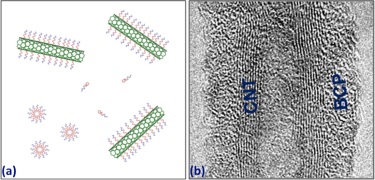Despite the remarkable features of carbon nanotubes (CNTs), their potential applications are frequently hindered by their low solubility and poor dispersion in solvents. Reporting in Nanotechnology, researchers successfully modify the surface of carbon nanotubes via encapsulation with amphiphilic block copolymers and determine the threshold for the complete coverage of CNTs by the polymer.
Wrapping process of carbon nanotubes
An efficient way to stabilise carbon nanotubes (CNTs) in solvents is via encapsulation. However, it is difficult to predict and control the appropriate dosages of copolymers and the assembled structures. Here, the researchers prepare a homogeneous dispersion of multiwalled CNTs with excellent stability. This involves the addition of amphiphilic block copolymers, polystyrene-block-poly(4-pyridine) (S4VP), into the dispersion of CNTs in acetic acid.
The amphiphilic block copolymer of S4VP improves the dispersibility of CNTs in acetic acid with the performance depending on the mass ratio of S4VP and CNTs, mBCP/mCNT. When mBCP/mCNT = 1, the CNTs suspend in acetic acid as large aggregates. At higher mass ratios the CNTs can homogeneously disperse and remain stable for more than six months when stored at room temperature. As the critical mBCP/mCNT is determined to be approximately 1.5, the mixture of S4VP and CNTs in acetic acid with mass ratios higher than this threshold contain not only S4VP-coated CNTs but also excessive S4VP chains. These excessive chains easily aggregate into micelles as the critical micellisation concentrations of block copolymers are typically very low.
What are the wrapped CNTs good for?
The presence of polymers coated on CNTs changes the surface properties of CNTs enabling further functionalisation and modification independent of the chemistry of CNTs themselves. The researchers perform atomic layer deposition (ALD) of TiO2 on both the pristine and S4VP-coated CNTs for 100 cycles. Transmission electron spectroscopy (TEM) reveals that TiO2 deposits on the pristine CNTs as isolated irregular bumps while TiO2 forms a continuous conformal layer along the surface of the S4VP-coated CNTs. This layer is approximately 1.5 nm thick along the surface of the S4VP-coated CNTs. The researchers successfully use the functionalised CNTs as building blocks for the fabrication of robust, highly permeable membranes for size-selective separations in their lab.

